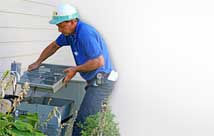Heating and Cooling - Install: How to efficiently cut costs and green your home
| Tweet |
With air conditioners and appliances running throughout the summer, it's easy to burn up energy and raise costs. In fact, the energy used in the average house is responsible for twice as many greenhouse gas emissions than the average car, according to the U.S. Environmental Protection Agency (EPA).
Pre-set indoor temperatures. One of the easiest and simplest things you can do is install a programmable thermostat. It will allow you to cut cooling costs up to 6 percent for every degree you raise your thermostat in the summer. Some models allow you to pre-set temperatures for every day of the week to match your family's comings and goings.
Reduce energy, increase home comfort. For efficient air conditioning, make sure your system meets the newest government energy standards. For example, you can save up to 47 percent on heating and air conditioning costs while reducing greenhouse gas emissions with the American Standard Allegiance (R) 15 Air Conditioner. It surpasses current government efficiency standards when installed as part of a complete system, and cools with an environmentally-friendly ozone-safe refrigerant to help keep costs to a minimum, even on the hottest days.*
Many energy-efficient air conditioner models meet efficiency requirements for a federal energy tax credit when installed as part of a complete system. Thanks to the passage of the American Recovery and Reinvestment Act, homeowners may be eligible for a tax credit if they purchase certain heating, ventilation and air conditioning systems by Dec. 31. For more information, visit americanstandardair.com/HomeOwner/LatestUpdates/Tax_Stimulus_2009.aspx.
Lights out, costs down. Increasing your lighting efficiency is one of the fastest ways to decrease your electricity bills, according to the U.S. Department of Energy (DOE). Turn lights off when you leave the room or add in a dimmer to see instant energy savings. Installing an occupancy sensor that automatically turns lights on and off when someone enters and leaves the room will also save energy and money. For example, you can save up to 50 percent energy when replacing a standard light switch with a Maestro Occupancy Sensor with eco-dim Dimmer from Lutron Electronics.
Shut out high energy bills. Your exterior door may be contributing to your home's overall energy usage. Newer models often fit and insulate better than older models and replacing your old door often reaps both energy- and money-saving benefits. The ENERGY STAR (R)-qualified Fiber-Classic (R) Mahogany Collection (TM) from Therma-Tru (R) creates the tightest seal possible, stabilizing interior temperatures and therefore decreasing your home's energy consumption.
Other simple savers. Even small acts of green can make a difference. The DOE recommends simple savers such as turning off your computer and monitor when not in use; lowering the thermostat on your water heater to 120 degrees; taking short showers instead of baths and washing only full loads of dishes and clothes. Visit www.energy.gov for more ideas.
* Potential energy savings may vary depending on your lifestyle, system settings, equipment maintenance, local climate, home construction and installation of equipment and duct system.
Courtesy of ARAcontent.


|
Respond Home Services Directory lists the top Contractors in your area, organized by specialty and office location. |
| Top Cities | |
|
Atlanta
Chicago New York |
Los Angeles
Philadelphia Washington DC |
| Canadian Cities | |
|
Calgary
Edmonton Ottawa |
Toronto
Vancouver Winnipeg |





